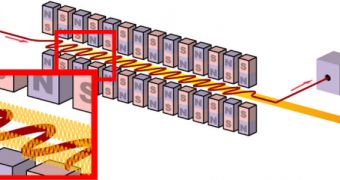As part of a contract with the United States Navy, the Boeing Company has just been awarded an additional $23 million in order to complete a lab demonstrator of a 100-kilowatt Free Electron Laser.
The FEL device is estimated to cost about $163 million overall. Cost estimates are however premature, given that the project has only been approved this March, following extensive review.
“The Free Electron Laser program will enable Navy ships to defend themselves against new threats with unprecedented speed, precision and power,” argues Greg Hyslop.
“It will transform naval warfare in the next decade by providing an ultra-precise, speed-of-light capability and unlimited magazine depth,” adds the official.
He is the vice president and general manager of Boeing Strategic Missile & Defense Systems. Hyslop adds that the critical design review phase of the FEL project will most likely be completed in the fourth quarter of 2011.
Additional testing will then take place in specialized labs, before any of the new weapons will be delivered to the battlefield.
The basic operating principle behind the machine is rather simple. High energy electrons are made into a beam, which is then passed through powerful magnetic fields. The end result is a massive laser emission.
“Two unique attributes of FELs are the ability to tune the wavelength to maximize transmission of the laser through the marine atmosphere, and the ability to aim for a single small spot on the target,” explains scientist Ed Pogue.
“The combination of these two effects allows the system to destroy the target in the minimum time,” adds Pogue, who is the program manager for the FEL project at Boeing.
Boeing is not working alone on this. Collaboration agreements exist between the company and Advanced Energy Systems, Niowave Inc. and SAIC.
In addition, several US Department of Energy (DOE) laboratories are involved in the effort as well.
These facilities include the Thomas Jefferson National Accelerator Facility, the Los Alamos National Laboratory, and the Argonne National Laboratory.
The work will largely be conducted at Los Alamos. The particle accelerator here is extremely suited for the construction of the FEL, and provides the US Navy with the best possible value for its money.

 14 DAY TRIAL //
14 DAY TRIAL //